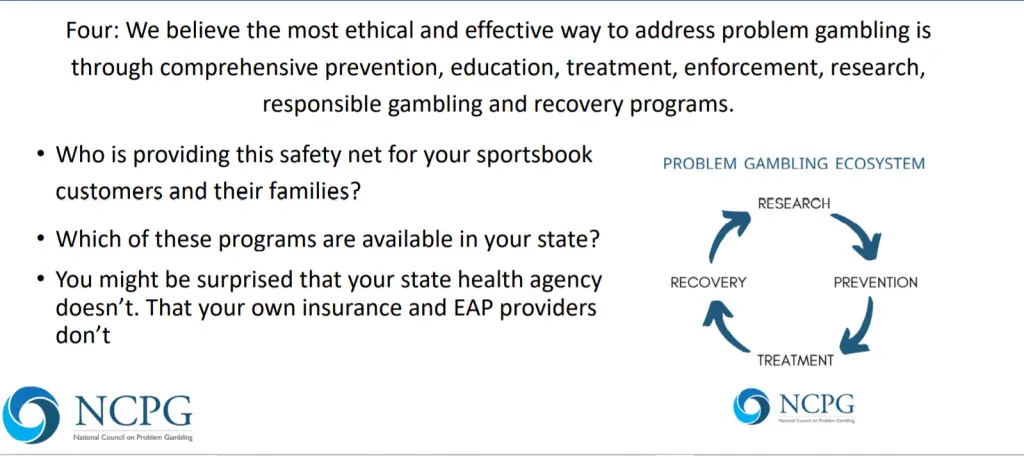NCPG Problem Gambling Symposium: 3 Things I Learned

Last week the National Council on Problem Gambling hosted its annual symposium, but like every other major industry get-together, the 2020 iteration of the NCPG symposium took place virtually.
I was fortunate to catch several presentations over the four-day conference, including a brilliant presentation by NCPG Executive Director Keith Whyte and Legislative Director Brianne Doura-Schawohl.
As an aside, if you ever have the opportunity, I highly suggest an NCPG event (conference or one of its webinars) as it will broaden your understanding of the gaming industry.
Whyte and Doura-Schawohl covered a lot of ground. Here are three problem gambling issues discussed during the presentation.
Gambling Does an Excellent Job of Tricking the Brain
The NCPG presentation did a terrific job explaining the different facets of gambling that ensnare people.
Gambling is a lot like an illusionist. In that it makes you see things that aren’t really there. Whether it’s finding seeming order in randomness, placing added emphasis on big wins while letting losses slip from the memory banks, linking independent events together, or overestimating small samples, gambling is very good at tricking the brain.
And games that have elements of skill take this illusion a step further. Skill-based forms of gambling (whether they are beatable or not) can create an illusion of control where none exists and fool a player into thinking the skill component makes it beatable if they study more and try harder.
Basically, the mechanics of gambling are exceptionally good at tricking our brains, and that helps explain the appeal of gambling and why some people get in over their heads.
The Cost of Problem Gambling is Significant
According to the NCPG, about six million Americans struggle with gambling disorders. The annual social cost of problem gambling is roughly $1,200 per person with a severe gambling problem in the form of criminal justice and healthcare costs. That works out to a $7.2 billion annual bill that falls on the government, a person’s family and friends, as well as the broader community.
Problem gambling doesn’t happen in isolation. It affects everyone.
Funding doesn’t come close to meeting that number, which is why prevention and early intervention is critical. It’s time for states across the country to end their extremely costly reactionary approaches to problem gambling and start funneling money into treatment and prevention.
Only five states devote more than $1 per capita to problem gambling: Massachusetts, Delaware, Ohio, Iowa, and Oregon. On the flipside, 11 states devote zero dollars to problem gambling, and that includes states with lotteries and other forms of gambling.
States can’t be ostriches and bury their heads in the sand. Miniscule funding, let alone zero dollars, simply cannot happen.
Few People Seek Out Treatment, But Treatment IS Successful
One of the most frustrating data sets was the following:
Only about 1% of current pathological gamblers seek treatment in a given year. That’s in stark contrast to substance abuse, where 20% seek treatment. The NCPG points to the shame, stigma, and lack of access to help and treatment for problem gambling for the discrepancy.
Another contributing factor is money. As the NCPG points out, insurance is unlikely to cover problem gambling treatment, and by the time a problem gambler seeks out help, they are likely to be in dire straits financially, since money is the substance they abuse.
What makes the 1% number even more frustrating is the results: treatment helps.
According to the NCPG, 65% of people that seek treatment for problem gambling report not gambling at follow up.
They also report:
- 75% decrease in illegal acts.
- 97% reduced participation in gambling.
- Significant improvements in family relationships, physical and mental health, job performance.
In Summary
Once again, say it with me, funding for problem gambling research, education, prevention, and treatment is sorely needed. States and/or the federal government need to start devoting adequate amounts of funding to these proven programs. Paying on the backend makes zero sense and isn’t helping anyone.
As the presentation states, problem gambling doesn’t begin with a clinical diagnosis:
“gambling problems encompass more than a clinical diagnosis of a gambling disorder. They can affect people whose gambling is just beginning to move beyond simple recreation, those on the path to recovery, and many points in between. We further believe that problem gambling services must address all individuals at any point on this continuum.”
To accomplish this, better funding (from government, operators, and any entity that benefits financially from gambling) is needed. Otherwise, one or more of the four pillars in the picture below disappears, the loop is cut, and everyone suffers the consequences.







